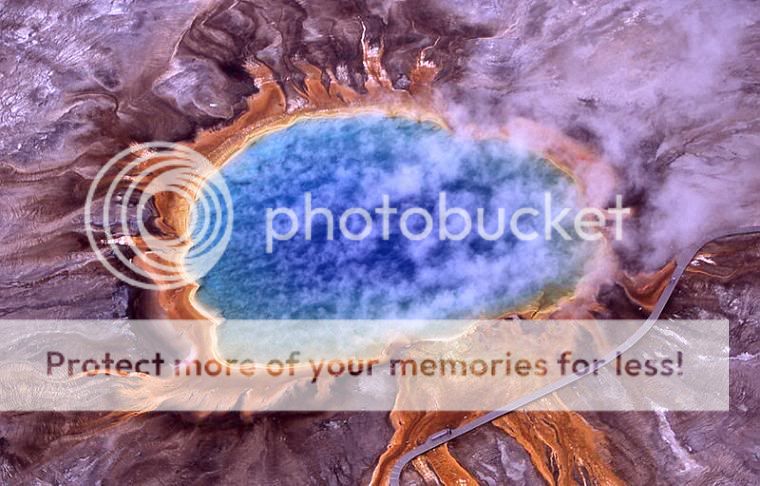
This cache is a short distance from the Midway Geyser Basin parking area. 
Grand Prismatic Spring (which I will abbreviate GPS from here on out, and not without a grin) is the largest hot spring in Yellowstone National Park. The more spectacular pictures of it always make me think that a rainbow splashed down from the sky and made this spectacular puddle for all to see.It is 200-300 feet (61m-91 m) across and is 160 feet (49 m) deep. The pool’s temperature of 170 degrees Fahrenheit (70 C) creates steam during much of the year, which contributes to otherworldly sights such as you see in the picture below, taken in October.

Nearly 500 gallons of water per minute pour from the springs here into the Firehole River nearby, due to the heat from an active volcano beneath them. Heated water rises from deep below the earth’s surface through fissures in the rocks, and emerges here at the GPS and other nearby springs. The hot water that issues up from below the earth’s surface has made runoff channels in all directions from the GPS. These channels are populated with extremophiles, which are organisms that live in physically or geochemically extreme conditions. The organisms that live here are a subspecies called thermophiles, because they love the incredible heat of the spring water, and actually require it to live. Enzymes from these thermophiles are useful to the biotechnology industry, including a DNA polymerase taken from Thermus aquaticus, which is found, among other places, in the hot springs of Yellowstone National Park.

If you look closely, you may see a lost ball cap or hoof prints out on the bacterial mats, but please do not step on, poke, or in any other way damage the mats themselves. The community of microorganisms that comprise the thick mats is an entire ecosystem unto itself.
To get credit for this cache:
1. Take a pic of you/your group and your GPS unit, with the Grand Prismatic Spring in the background, and upload with your log.
2.Include in your log your favorite aspect of your visit to the GPS. Feel free to gush at length, even though this hydrogeological feature is not a geyser.
3. Send an email to the cache owner. Include the following information:
A. The four colors found at the GPS, according to signage, and what causes each.
B. Names of 3 thermophilic cyanobacteria found here.
C. The two layers found in the bacterial mats, and the function of each.
Any logs containing the email-only info will regrettably be deleted. No armchair/last-summer’s-vacation-pic finds, please. If I do not receive your emailed answers within one week of receiving your log notice, I will delete your find.
Did you know that the color of the bacterial mats changes during the course of the seasons? Steam rises from hot and sterile deep azure blue water (owing to the light absorbing overtone of an OH stretch which is shifted to 698 nm by hydrogen bonding) in the center surrounded by huge mats of brilliant orange algae and bacteria. The color of which is due to the ratio of chlorophyll to carotenoid molecules produced by the organisms. During summertime the chlorophyll content of the organisms is low and thus the mats appear orange, red, or yellow. However during the winter, the mats are usually dark green, because sunlight is more scarce and the microbes produce more chlorophyll to compensate, thereby masking the carotenoid colors.
Sources: Wikipedia: Grand prismatic spring, Thermophile, Extremophile, Yellowstone, National Park Service, Yellowstone Park Foundation
Frumious Jane is the author of the Caching Out geocaching mystery series, written under the name Morgan C. Talbot.